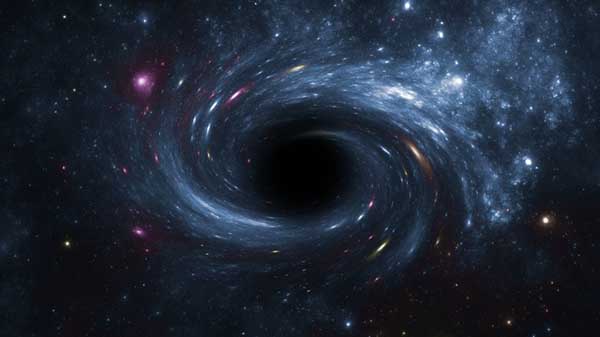Huge black hole at centre of our galaxy ‘is pointing a jet straight at Earth’

The monstrous black hole at the centre of our Milky Way galaxy is four million times the mass of our sun – and is pointing a ‘jet’ of energy directly at us, scientists believe.
Earth is not in danger, but scientists using the powerful ALMA telescope believe that the radio jet emitted by the black hole is pointing towards Earth.
Scientists are currently battling to produce a sharp image of the black hole, which is hidden in a foggy cloud of hot gas.
The black hole, known as Sagittarius A* is thought to pull in stars, gas clouds and planets, devouring them with its huge gravity.
Heino Falcke, Professor of Radio Astronomy at Radboud University, says, ‘Maybe we are looking at this beast from a very special vantage point.’
MORE: Report into ‘filthy’ HMP Bedford reveals inmate was spotted catching a rat during prison inspection
MORE: Miracle puppy: Chihuahua weighing just 1lb survives after being snatched by hawk and dropped from sky
Reearchers found that the bulk of the radio signal is coming from 300 millionths of a degree.
Sara Issaoun of Radboud University says, ‘This may indicate that the radio emission is produced in a disk of infalling gas rather than by a radio jet.
‘However, that would make Sgr A* an exception compared to other radio emitting black holes. The alternative could be that the radio jet is pointing almost at us.’
Supermassive black holes are common in the centers of galaxies and may generate the most energetic phenomena in the known universe.
It is believed that, around these black holes, matter falls in a rotating disk and part of this matter is expelled in opposite directions along two narrow beams, called jets, at speeds close to the speed of light, which typically produces a lot of radio light.
Whether the radio emission we see from Sgr A* comes from the infalling gas or the outflowing jet is a matter of intense debate.
Study author Antranik Sefilian, a PhD student at Cambridge said, ‘The Planet Nine hypothesis is a fascinating one, but if the hypothesized ninth planet exists, it has so far avoided detection.
‘We wanted to see whether there could be another, less dramatic and perhaps more natural, cause for the unusual orbits we see in some TNOs.
‘We thought, rather than allowing for a ninth planet, and then worry about its formation and unusual orbit, why not simply account for the gravity of small objects constituting a disk beyond the orbit of Neptune and see what it does for us?’
‘If you remove planet nine from the model, and instead allow for lots of small objects scattered across a wide area, collective attractions between those objects could just as easily account for the eccentric orbits we see in some TNOs.’

 Yahoo News
Yahoo News 
